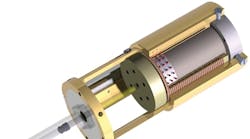Afraid of needles? New needleless drug delivery mechanisms could soon eliminate scary pinpricks and benefit needle-averse patients and healthcare workers alike. Needleless devices could also boost compliance among patients who might otherwise avoid the discomfort of regularly injecting themselves with drugs such as insulin.
“If you’re afraid of needles and have to frequently self-inject, compliance can be an issue,” says Catherine Hogan, a research scientist in MIT’s Department of Mechanical Engineering. “We think this kind of technology gets around some of the phobias that people may have about needles.”
Over the past few decades, scientists have developed various alternatives to hypodermic needles. For example, nicotine patches slowly release drugs through the skin to help people quit smoking. However, these patches can only release drug molecules small enough to pass through the skin’s pores, limiting the types of medicine that can be delivered. With the introduction of larger protein-based drugs on the rise, researchers have been developing new technologies capable of delivering them including jet injectors, which produce a high-velocity jet of drugs that penetrate the skin. Several such devices already on the market have drawbacks. The mechanisms they use, particularly in spring-loaded designs, are essentially “all or nothing,” releasing a coil that ejects the same amount of drug to the same depth every time.
Now, the MIT team led by mechanical engineering professor Ian Hunter has engineered a highly controllable jet-injection system that delivers a range of doses to variable depths. The design is built around a Lorentz-force actuator — a small, powerful magnet surrounded by a coil of wire attached to a piston inside a drug ampoule. When current is applied, it interacts with the magnetic field to produce force that pushes the piston forward, ejecting the drug at high pressure and velocity (almost the speed of sound) through the ampoule’s nozzle, an opening as wide as a mosquito’s proboscis.
The speed of the coil and the velocity imparted to the drug can be controlled by the amount of current applied. Resulting waveforms generally consist of two distinct phases — an initial high-pressure phase in which the device ejects the drug at sufficient velocity to breach the skin and reach the desired depth, and a lower-pressure phase during which the drug is delivered in a slower stream that can easily be absorbed by surrounding tissue. Various skin types may require different waveforms to deliver adequate drug volumes to the desired depth.
“If I’m breaching a baby’s skin to deliver vaccine, I won’t need as much pressure as I would need to breach adult skin,” Hogan explains. “We can tailor the pressure profile to do that.”
The team is also developing a version of the device for transdermal delivery of drugs ordinarily found in powdered form by programming the device to vibrate, turning powder into a “fluidized” form that can be delivered through the skin much like a liquid. Such powder delivery may help solve what’s known as the cold-chain problem: Vaccines delivered to developing countries need to be refrigerated if they are in liquid form. When coolers break down, entire batches of vaccines are spoiled. A vaccine that can be administered in powder form requires no cooling, avoiding this issue.
Article on larger Lorentz-force motors: motionsystemdesign.com/mag/lorenzforce_motors
Another needleless design: medicaldesign.com/pumps-valves/needless_injection_site_one-way_valve
